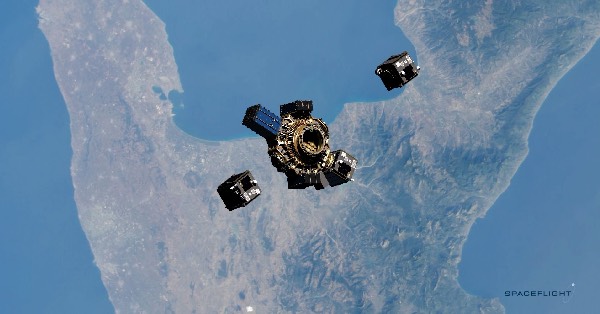Agreement expands availability of last-mile smallsat delivery via European missions
Spaceflight Inc., the leading global launch services provider, today announced it signed an agreement with SAB Launch Services S.r.l. (SAB LS) to fly its Sherpa® orbital transfer vehicles (OTVs) on Arianespace Vega missions. The agreement extends Spaceflight launch capacity on European missions managed by Arianespace for Spaceflight’s OTV-based services on launches starting as soon as next year. The companies are also partnering to offer customers access to shared integration and storage facilities across the U.S. and Europe.
“We continue to see growing customer interest in launches that can deliver a variety of payload types and sizes to specific orbital destinations,” said Curt Blake, CEO and president of Spaceflight. “Our proven propulsive OTVs allow us to provide unprecedented flexibility and in-space transportation services. We’re excited to build on our already strong relationship with SAB and expand the Spaceflight portfolio of launch partners to include Vega for our family of Sherpa vehicles.”
Italy-based SAB is part of SAB Group and provides launch services on European launchers, including Vega and Vega C multi-payload missions.

“This agreement formalizes a co-operation which started last year,” commented Marco Mariani, CEO of SAB Launch Services. “For us, Spaceflight is a strategic partner which helped to open up to the U.S. commercial and institutional market. Now we have a common strategy to provide more solutions to our customers. Spaceflight’s Sherpa OTVs will be an opportunity to grant flexibility to our missions and to be ready to face a developing market populated by increasing numbers of smallsats.”
Spaceflight’s Sherpa family of space vehicles is designed to minimize development timelines while maximizing launch schedule reliability and mission assurance. Beyond functioning as a port expander, the modular and flexible transportation vehicles bridge the gap between where a launch vehicle drops its satellites off and the satellites’ final destination orbit – whether that’s LEO, trans-lunar and low-lunar orbits, or beyond to geosynchronous equatorial orbit (GEO). In addition to precise orbit insertion, Sherpa OTVs support payload hosting, as well as in-space servicing, such as spacecraft maintenance, infrastructure development, and debris mitigation.
Spaceflight’s first mission aboard the Vega launch vehicle was on VV16, Arianespace’s first dedicated rideshare mission which successfully lifted off from the Guiana Space Center in Kourou, French Guiana in September 2020. Spaceflight provided mission management and rideshare integration services for 28 customer payloads onboard the mission.
Most recently, Spaceflight successfully launched Sherpa-AC onboard SpaceX’s Transporter 5 in May 2022 and plans to launch its chemical propulsive OTV, Sherpa LTC, later in the year. Its Sherpa-ES, a bipropellant, high delta-V OTV, will launch aboard the much-anticipated lunar slingshot mission, GEO Pathfinder in 2023. Previously, the company launched 50 payloads in 2021 from three different Sherpa OTVs, establishing a strong history of success with the program.
SAB-LS has a leading position in the European launch service market dedicated to smallsats, and is now looking to the future with this partnership and with the development of the IOSHEX based services. IOSHEX is a Space Tug leveraging on the heritage of the SSMS Dispenser. The hardware is being developed by the sister company SAB Aerospace and the initiative of flying the Sherpa on VEGA is sinergetic to the company’s vision to play a role on the In Orbit Servicing market.
This agreement comes after the success of the VEGA C maiden flight. The partnership between SAB and Spaceflight highlights U.S. customers’ appreciation of the European Launch services. By accessing European Launch Services, in addition to U.S.-based services, clients will have access to increased flexibility through a diverse launch schedule with multiple launch opportunities within a year, offering more orbits, different inclinations, and more.
The next Vega C missions are planned before the end of 2022, and in January 2023 where Vega C will fly its first rideshare with the SSMS hosting a vast aggregate of mini and micro satellites as well as CubeSats.






































